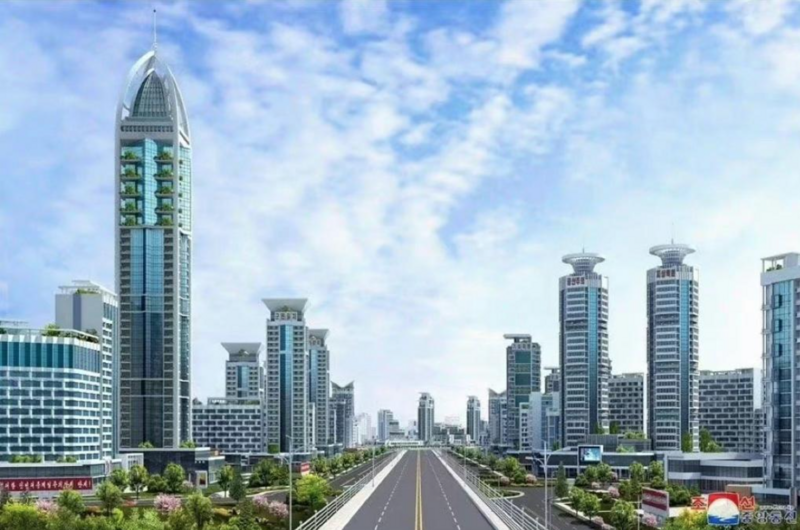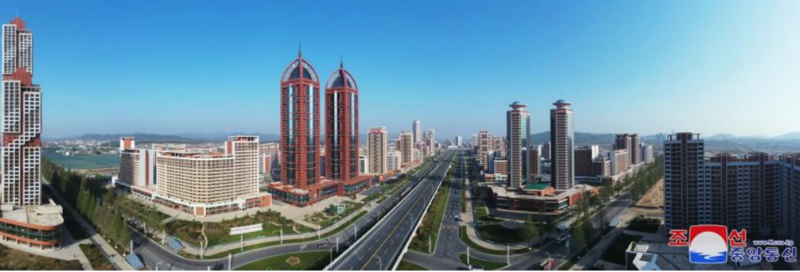In the first blog of this series, we introduced the 10,000 new flats on Rimhung Street, which marks the second stage of the Hwasong District development. In part two, we delved into the meaning of the term “Phase” within the North Korean context and highlighted the initial phase of the 50,000 New Flats Project in Pyongyang.
This blog post will focus on the second phase of the Pyongyang Flats Project, specifically the first stage of the Hwasong District, featuring the 10,000 new flats constructed in 2022.
This area is also referred to as Hwasong Street.
Understanding “Stage” in North Korea
In the previous blog, we introduced the term “Phase.”
Now, we will discuss a related term, “Stage.”
In North Korea, “Stage” and “Phase” convey similar concepts, both representing sequential steps in executing a plan. However, a “Stage” serves as a more specific subdivision within a “Phase.”
In the context of the 50,000 New Flats Project in Pyongyang, the Hwasong District comprises the second to fourth Phases. Within this district, Hwasong Street represents the first Stage, while Rimhung Street denotes the second Stage.
Key Facts About Hwasong Street
On February 12, 2022, North Korea celebrated the launch of the 10,000 new flats construction project in Pyongyang for that year.
Hwasong District is situated in North Pyongyang and was previously part of Ryongsong District. Two months post-construction, the Hwasong Area was designated as its own district.
Hwasong Street runs along the route from Pyongyang Sunan International Airport to the heart of Pyongyang.
This positioning might make Hwasong Street one of the first striking new building complexes that travelers notice upon arriving in North Korea by plane.
Furthermore, the Kumsusan Palace of the Sun lies southeast of this area, in close proximity. This has historically limited large-scale urban development in the region.
Building New Structures in Pyongyang Amid a Pandemic
Hwasong Street has a challenging and notable history.
In May 2022, North Korean state media recognized the widespread transmission of COVID-19 in the country, officially removing North Korea from the list of nations reported as COVID-free.
As a reaction to the outbreak, Kim Jong Un announced a “severe national emergency” and enforced a nationwide lockdown.
On May 12, 2022, an emergency meeting convened by the Workers’ Party of Korea addressed the current situation.
During that meeting, it was affirmed that the construction of the Hwasong area was a top priority for 2022. Therefore, construction activities were to continue unhindered by the lockdown, meaning workers were required to carry on amidst the pandemic.
On April 16, 2023, shortly after the Day of the Sun (which is no longer recognized), North Korea held a completion ceremony for the Hwasong District, marking the conclusion of 14 months of construction and establishing these new buildings as a fresh landmark for the city.
Meaning Behind the Name Hwasong
What does the name Hwasong (화성) really signify?
If you’re familiar with North Korea’s military, you may recognize the name “Hwasong Street.” “Hwasong” corresponds to the North Korean ballistic missile “HwasongPo,” which translates to “Missile of Mars.”
However, when referring to Hwasong Street, “Hwa” and “Song” translate to “harmony and prosperity.”
The name is derived from a historical site in the area known as Hwasong Jae, which aimed to motivate locals toward diligent study to cultivate harmony and prosperity. A “Jae” denotes a traditional East Asian building used for storing literary works, drawings, and writings.
The Hwasong missile symbolizes national pride and serves as a well-known emblem of North Korea. Thus, given the shared name with the missile, North Korea likely seeks to showcase its architectural prowess and distinctive Juche-style designs.
Overview of Hwasong Street
Let’s take a closer look at the new buildings lining Hwasong Street.
The overall color palette of Hwasong Street features light red, reddish-brown, and white, with an architectural style comparable to Future Scientists Street.
The new constructions embody classic futuristic Juche-style architecture, incorporating elements reminiscent of missiles and even UFOs. Among all the newly erected buildings in Pyongyang, this street stands out prominently.
It’s also noteworthy that Hwasong Street houses a Matusan Electric Vehicle Exhibition Hall.
Initial images of Matusan electric vehicles raised speculations that they were simply rebadged BYD cars. So, when touring with Koryo Tours, feel free to inquire with your local Korean guides regarding the developments in electric vehicles in North Korea.
If you’re interested in detailed footage of the Matusan electric vehicles, a video from the Matusan Economic Federation provides an introduction to their lineup.
Landmarks on Hwasong Street
Now, let’s examine the notable landmarks on Hwasong Street.
The most distinctive landmark is a set of twin towers designed to resemble missiles, each standing 40 stories tall. While the initial design included just one such building, the final construction featured two, with the inclusion of military and technological motifs owing to their association with the Hwasong missile.

The initial design concept for Hwasong Street.
Opposite the missile-shaped twin towers, there are another set of twin towers, each 30 stories tall, with unique UFO-shaped rooftops, adding to the eclectic architectural landscape.
Another feature along Hwasong Street is a pair of twin towers with identical designs but differing floor counts.
These two buildings were introduced in September 2022 following an inspection by Kim Jong Un, who felt the original plan left excessive open space, rendering the street aesthetically unbalanced. To address this, over 2,000 new flats were added to fill the vacant land.
One of these towers reaches 60 stories high, while the other stands at 30 stories. The main structures of these twin towers are light red, embellished with a spiral-wrapped white pattern that enhances their visibility at night, thanks to their unique lighting features.

These three sets of twin towers are visible from left to right.
The Future of New Developments in Pyongyang
The construction of Hwasong District has already completed Stage 1 and Stage 2 in 2022 and 2023, respectively.
Stage 3 is underway in 2024, with Stage 4 planned for future execution.
Once all four stages are finished, a unique urban landscape combining diverse forms of Juche-style architecture will be realized.
Hopefully, tours scheduled for 2026 will allow us to witness the Hwasong District New Urban area in person.
As North Korea has announced that international tourism in the Samjiyon area will soon resume later this year, be sure to check our website and social media for the latest updates on North Korean tourism.



